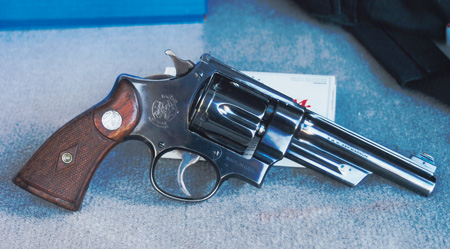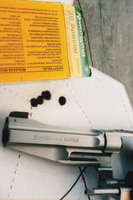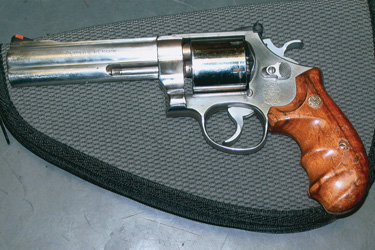

Phil Sharpe, Elmer Keith, and other experts of the time were involved in the development of the .357 Magnum.
The country was in a depression, and 1935 was not a commercially ideal time for Smith & Wesson to introduce its most expensive revolver ever. As Askins had noted, the guns were virtually hand built, and luxuriously finished, each fitted with an adjustable rear sight and the shooter’s choice of front blade.
The company kept records on the individuals who ordered these bespoke revolvers, and a great chapter of handgun history thus opened: the era of the Registered Magnum. Explained Dave Arnold, “Each revolver was registered to its new owner and was accompanied by a certificate bearing the customer’s name. In addition, the registration number on the certificate, which had the suffix ‘Reg.’, was stamped on the crane recess of the frame. The revolver had a bright blue finish in keeping with its fine fit and finish.”

The Great Depression notwithstanding, demand for these guns greatly exceeded S&W’s expectations, and soon the custom/registration thing became unwieldy. Production ceased in late 1941 as the United States went onto a war footing.
After the war, as S&W eased back into production of guns in demand by consumers, the .357 Magnum did not make its reappearance until 1948. It was upgraded with heavier duty sights, and with the short action modification that accompanied all of the company’s postwar double action revolvers.
In 1957, Smith & Wesson gave numeric designations to all its handgun models. The original .357 Magnum became the Model 27 and its plain-Jane economy version, the Highway Patrolman, was designated Model 28. Various dash-suffixes appended the Model 27 name as the gun underwent such production economies as going from five-screw to four-screw frames, and then to three-screw, changes in ejector rods, and other minor updates.
Against increasing competition – lighter guns, smaller ones, and of course, cheaper ones – Model 27 sales dwindled. In the late 1980s, S&W produced a stainless version, the Model 627, which featured stainless construction, a 5-inch heavy underlugged barrel, and a non-fluted cylinder. It did not look like a Model 27, and it did not sell well. By 1994, the Model 27 had disappeared from the Smith & Wesson catalog. It had been long since pre-deceased by the Model 28.
The concept of an N-frame .357 would not resurface again until the 21st century, and then in a very 21st century context. The new (and currently available) Model 327 series uses Scandium in place of steel to bring down weight.
Strongly encouraged by Miculek, the factory discovered that modern metallurgy allowed the large .44-frame cylinder to be bored with eight .357 Magnum chambers instead of the original six. It has been produced in formats ranging from a snub-nose with truncated grip frame to a huge, optically sighted competition gun complete with Picatinny accessory rail under its sculpted medium-heavy barrel.
Though it has not caught on as a defensive weapon, the latter model shows promise in bowling pin shooting and for ICORE (International Congress of Revolver Enthusiasts) matches.

Barrel Length Factor
Over the years, the Model 27 series has been produced in a great variety of barrel lengths. There are few handguns whose fans are so split as to ideal barrel length. During the Registered Magnum years, the ordering customer could specify whatever barrel length he or she desired.
Noted Arnold, “The .357 Magnum revolver was first made in two main barrel lengths – 3-1/2 and 8-3/4 inches.” The guns that Douglas Wesson used on his spectacular big game hunts may well have been the latter length, and not 8-3/8 inches as Keith wrote.
The reduction from 8-3/4 to 8-3/8 inches as maximum length came about after Smith & Wesson discovered that their longest barrel exceeded the maximum length allowed in competition at the time. To achieve the maximum allowed sight radius, 10 inches, the barrel had to be shortened to the 8-3/8 inches dimension.
Soon the company was making 4-, 5-, 6-, and 6-1/2-inch barrels among their standard offerings. I have heard of, but not handled, 7-1/2-inch versions.
Each had its adherents, because in this gun, the balance and overall esthetics changed significantly with barrel length. So, of course, did its ballistics. The .357 Magnum cartridge in most of its loadings dropped velocity dramatically as barrel length shortened.
The great double action revolver expert of the mid-20th century, Bob Nichols, appeared to favor the 3-1/2-inch barrel. However, he also said of this gun, “The .357 Magnum is a lot of gun for any man to hold; and it’s too much gun for the average man.”
J. Edgar Hoover’s Smith & Wesson .357 Magnum (now lost to history, and believed to have been passed on to a relative of Hoover’s heir Clyde Tolson) may have had a 3-1/2-inch barrel. Certainly General Patton’s did. Writes modern authority John Taffin, an enthusiast who owns them in virtually all barrel lengths, “…we have the short-barreled 3-1/2-inch .357 Magnum that is absolutely the most business-like looking sixgun ever made available. Dirty Harry did not originate ‘Make my day!’, the 3-1/2-inch .357 Smith & Wesson Magnum did!”

Charles Askins’ original .357 Magnum had a 4-inch barrel. So did the specimen Walter Walsh used to kill Al Brady in that famous Maine gunfight.
The 5-inch barrel was perceived by many as having the best balance, in both the visual and the tactile sense, of any of the slender barrels ever fitted to this large-frame, heavy-cylindered revolver. Skeeter Skelton was particularly fond of the 5-inch and influenced so much demand among his loyal readers that Smith & Wesson reportedly produced a short run of 5-inch Model 27s to satisfy the clamor.
The 6-inch and 6-1/2-inch barrels were ideally in proportion to the .44-size frame, in the eyes of some other enthusiasts. Many of the police departments that adopted these original .357 Magnums during their heyday seem to have gone to one or the other of these lengths, the New Hampshire State Police for example.
The 8-3/8-inch barrel was unique to this gun until the coming of the Smith & Wesson .44 Magnum in the mid-1950s. Ed McGivern seems to have used this length more than any other. Chic Gaylord, an influential gun expert in the ‘50s and ‘60s, wrote: “One of the finest sidearms to take along on a hunt is Smith & Wesson’s .357 Magnum with the eight-and-three-eighths-inch barrel. It shoots as straight as a rifle and packs a lot of authority.”
To read Part I of this series, click here.
To read Part III of the series, click here.
This article is an excerpt from the new book Massad Ayoob's Greatest Handguns of the World. To learn more, Click Here.

Next Step: Get your FREE Printable Target Pack
Enhance your shooting precision with our 62 MOA Targets, perfect for rifles and handguns. Crafted in collaboration with Storm Tactical for accuracy and versatility.
Subscribe to the Gun Digest email newsletter and get your downloadable target pack sent straight to your inbox. Stay updated with the latest firearms info in the industry.

![Best Concealed Carry Guns In 2025 [Field Tested] Wilson Combat EDC X9S 1](https://gundigest.com/wp-content/uploads/Wilson-Combat-EDC-X9S-1-324x160.jpg)


![Best 9mm Carbine: Affordable PCCs [Tested] Ruger Carbine Shooting](https://gundigest.com/wp-content/uploads/Ruger-Carbine-Shooting-100x70.jpg)
![Best AR-15: Top Options Available Today [Field Tested] Harrington and Richardson PSA XM177E2 feature](https://gundigest.com/wp-content/uploads/Harrington-and-Richardson-PSA-XM177E2-feature-100x70.jpg)
